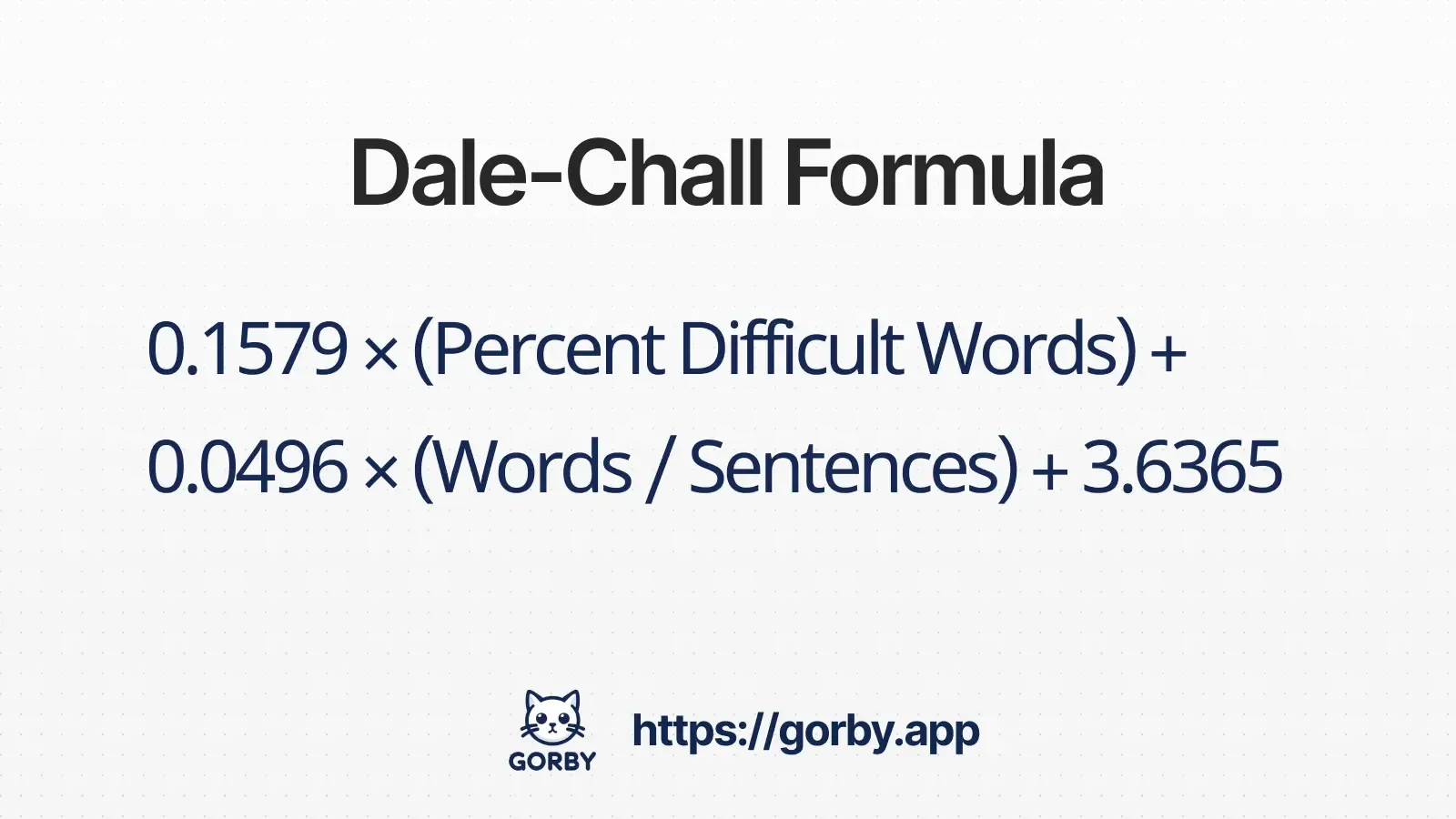Dale-Chall Readability Index Calculator
Assess your text's comprehension difficulty using the Dale-Chall Readability Index. Unlike other formulas that rely on word length, Dale-Chall evaluates text complexity based on word familiarity, making it particularly effective for educational content, technical documentation, and professional writing where reader comprehension is crucial.
Understanding the Dale-Chall Readability Index
What is the Dale-Chall Readability Index?
The Dale-Chall Readability Index is a sophisticated formula that measures text comprehension difficulty by analyzing word familiarity and sentence structure. Unlike other readability formulas that rely on word length, Dale-Chall evaluates text against a carefully curated list of words that fourth-grade American students can reliably understand, considering any word not on that list to be potentially challenging.
This unique approach makes Dale-Chall particularly effective for educational materials, technical documentation, and professional writing where precise assessment of vocabulary complexity is crucial. The formula provides a numeric gauge that correlates with specific grade levels, helping writers ensure their content matches their audience's reading abilities.
Origins and Development
Created by Edgar Dale and Jeanne Chall, the formula was first published in 1948 in their groundbreaking article "A Formula for Predicting Readability". The original version used a list of 763 words that 80% of fourth-grade students were familiar with. This approach revolutionized readability assessment by focusing on vocabulary familiarity rather than traditional metrics like word length or syllable count.
In 1995, the formula was significantly updated and published as "The New Dale-Chall Readability Formula", expanding the word list and refining the calculation methods. This revision addressed changes in contemporary vocabulary knowledge and improved the formula's accuracy across different types of texts.
You can explore the complete Dale-Chall word list used by this calculator, which contains approximately 3,000 familiar words and forms the basis for determining text complexity.
How Dale-Chall Stands Apart
What makes Dale-Chall unique is its word familiarity approach. While other formulas like Flesch-Kincaid rely on word length or syllable count to estimate difficulty, Dale-Chall directly measures vocabulary complexity through empirically validated word lists. This method offers several distinct advantages:
- More accurate assessment of vocabulary difficulty
- Better evaluation of technical and specialized content
- Stronger correlation with actual reading comprehension
- More reliable results for educational materials
Modern Applications
Today, the Dale-Chall formula remains a vital tool across various fields. It's particularly valuable in education, where it helps ensure textbooks match student reading levels, and in professional communication, where clear comprehension is crucial. Government agencies often use it to ensure public documents are accessible, and content creators rely on it to optimize their writing for specific audience levels. The formula's emphasis on word familiarity makes it especially relevant in an era where clear communication and accessibility are increasingly important.
The Dale-Chall Formula Explained

Understanding the Components
The Dale-Chall formula combines two key measurements with carefully calibrated weights to determine reading difficulty. Let's break down each component:
Percentage of Difficult Words
The first part of the formula (0.1579 × percent difficult words) measures vocabulary complexity. A word is considered "difficult" if it's not on the Dale list. This factor is given more weight in the formula, reflecting the critical role of vocabulary in comprehension.
Average Sentence Length
The second part (0.0496 × words per sentence) evaluates sentence complexity through length. Longer sentences often contain more complex ideas or multiple concepts. The lower weight balances this factor's influence on the final score.
Adjustment Constant
The addition of 3.6365 adjusts the raw score to align with U.S. grade levels. This calibration ensures the final score corresponds meaningfully to education levels, making the results practical for educational use.
Word Counting Guidelines
The Dale-Chall formula includes specific rules for counting words as familiar or unfamiliar. You can view the complete list of 3,000 familiar words used in the formula. When analyzing text, these rules apply
- Regular plurals, possessives, and common verb forms of familiar words count as familiar
- Proper nouns and names are counted as familiar words
- Hyphenated words are familiar only if both parts are on the familiar list
Dale-Chall Grade Level Scale
The Dale-Chall score directly corresponds to U.S. education grade levels, providing a clear understanding of the reading ability required to comprehend your text. Here's a comprehensive breakdown of scores and their interpretations.
| Score Range | Grade Level |
|---|---|
| 4.9 or lower | 4th grade or lower |
| 5.0–5.9 | 5th to 6th grade |
| 6.0–6.9 | 7th to 8th grade |
| 7.0–7.9 | 9th to 10th grade |
| 8.0–8.9 | 11th to 12th grade |
| 9.0–9.9 | College level |
Interpreting Dale-Chall Scores
The ideal Dale-Chall score depends entirely on your target audience. While lower scores generally indicate better readability, some content requires higher complexity. Here's what you should know:
General Audience Content
Aim for scores between 6.0-6.9 (7th-8th grade level). This range is accessible to most readers while maintaining professional credibility.
Technical Documentation
Scores between 7.0-8.9 are acceptable, reflecting the complex nature of technical subjects while still maintaining clarity.
Academic Writing
Scores of 9.0-9.9 are common and often necessary, reflecting the sophisticated concepts and vocabulary required for college-level content.
Public Communications
Aim for scores of 6.0 or lower for public-facing content like government documents, medical instructions, or general information materials.
📝 Pro Tip
When in doubt, remember that the average adult in the United States reads at approximately an 8th-grade level (score around 6.0-6.9). Unless your content specifically requires higher complexity, aiming for this level ensures maximum accessibility while maintaining professional standards.
Dale-Chall Index vs other readability metrics
While several readability formulas exist, the Dale-Chall index offers unique advantages through its word familiarity approach. Here's how it compares to other popular metrics:
Automated Readability Index
Uses character count instead of word familiarity. While faster to compute, it may miss nuances in vocabulary difficulty that Dale-Chall captures. ARI is better suited for quick assessments, while Dale-Chall provides more accurate vocabulary-based analysis.
Flesch-Kincaid
Relies on syllable counts and sentence length. While widely used, it can sometimes underestimate the complexity of texts with simple words that are uncommon or specialized. Dale-Chall's word familiarity approach often provides better results for technical or specialized content.
Coleman-Liau
Focuses on characters per word rather than word difficulty. While this approach works well for general texts, it may not catch subtle vocabulary challenges that Dale-Chall identifies through its word familiarity assessment.
SMOG Index
Calculates grade level based on number of polysyllabic words. While effective for health and medical content, it may overestimate difficulty of technical terms that are actually familiar to the target audience. Dale-Chall's empirical word list provides more nuanced vocabulary assessment.
When to Choose Dale-Chall
Dale-Chall is particularly valuable when vocabulary comprehension is crucial, such as in educational materials, technical documentation, or content for specific reading levels. Its word familiarity approach makes it especially suitable for evaluating content where understanding specific terms is more important than sentence complexity.
Tips to Improve Your Dale-Chall Score
Vocabulary Choices
- • Use common, familiar words when possible
- • Replace specialized terms with everyday alternatives
- • Define technical terms when they can't be avoided
- • Use consistent terminology throughout your text
Sentence Structure
- • Keep sentences under 20 words when possible
- • Vary sentence length for better flow
- • Use active voice to improve clarity
- • Break complex ideas into simpler sentences
Content Organization
- • Begin with familiar concepts before introducing new ones
- • Use clear transitions between ideas
- • Group related information together
- • Include explanatory context for complex terms
Review Process
- • Check Dale-Chall score regularly while writing
- • Pay special attention to specialized vocabulary
- • Get feedback from your target audience
- • Use glossaries for necessary technical terms
Remember: The goal isn't always to achieve the lowest possible Dale-Chall score. Instead, aim for a score that matches your target audience's reading level while maintaining the accuracy and professionalism your content requires. Focus particularly on using familiar words where possible, as vocabulary choice has the largest impact on your Dale-Chall score.
Ready to Analyze Your Text?
Get comprehensive readability insights with Gorby's complete text analysis toolkit.
Try our text analyzer to see all readability scores, including Dale-Chall, ARI, Coleman-Liau, and more, in one place. Check word counts, readability metrics, and get writing suggestions instantly.
Resources and References
Original Research Paper (1948)
Dale, E. and Chall, J.S. "A Formula for Predicting Readability" - The foundational paper that introduced the Dale-Chall formula and its innovative word familiarity approach.
Readability Revisited: The New Dale-Chall Formula (1995)
Chall, J.S. and Dale, E. - The comprehensive update to the original formula, expanding the word list and refining the calculation methods for modern usage.
Dale-Chall Readability Formula
Wikipedia article providing a comprehensive overview of the formula's history, methodology, and applications in readability assessment.
Using a Computer to Calculate the Dale-Chall Formula
Barry, J.G. and Stevenson, T.E. - A paper on automating readability calculations, demonstrating early efforts to make the Dale-Chall formula more accessible through computer implementation.
More Readability Tools
All Readability Metrics
Overview of all readability formulas and tools
Automated Readability Index (ARI)
Calculate grade level based on character count
Coleman-Liau Index
Analyze text complexity using characters per word
Flesch Reading Ease
Measure text readability on a 100-point scale
Flesch-Kincaid Grade Level
Convert text complexity to U.S. grade levels
Gunning Fog Index
Measure text complexity using sentence length and word difficulty
SMOG Index
Assess readability based on polysyllabic words
Spache Readability Formula
Evaluate early reading materials using familiar word lists
Footer

Transform your writing from good to exceptional. Smart text analysis tools that help you craft content that resonates.
Core Features
Advanced Analysis
Company
© 2025 Gorby. All rights reserved.